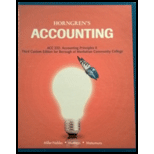
Accounting for notes receivable, dishonored notes, and accrued interest revenue Consider the following transactions for Jo Jo Music.
2016
Dec. 6 Received a $9,000, 90-day, 12% note in settlement of an overdue
31 Made an
31 Made a closing entry for interest revenue.
2017
Mar. 6 Collected the maturity value of the Concord Sounds note.
Jun. 30 Loaned $11,000 cash to Main Street Music, receiving a six-month, 12% note.
Oct. 2 Received a $9,000, 60-day, 12% note for a sale to Salem Sounds. Ignore Cost of Goods Sold.
Dec. 1 Salem Sounds dishonored its note at maturity.
1 Wrote off the receivable associated with Salem Sounds. (Use the allowance method.)
30 Collected the maturity value of the Main Street Music note.
Journalize all transactions for Jo Jo Music. Round all amounts to the nearest dollar. (For notes stated in days, use a 360-day year.)
Want to see the full answer?
Check out a sample textbook solution
Chapter 9 Solutions
ACCOUNTING PRINCIPLES 222 5/16 >C<
- Please provide the solution to this general accounting question using proper accounting principles.arrow_forwardI am looking for help with this general accounting question using proper accounting standards.arrow_forwardCan you demonstrate the accurate method for solving this General accounting question?arrow_forward
- Can you explain this general accounting question using accurate calculation methods?arrow_forwardI need help with this general accounting question using the proper accounting approach.arrow_forwardI am searching for the accurate solution to this general accounting problem with the right approach.arrow_forward
 Financial Accounting: The Impact on Decision Make...AccountingISBN:9781305654174Author:Gary A. Porter, Curtis L. NortonPublisher:Cengage LearningPrinciples of Accounting Volume 1AccountingISBN:9781947172685Author:OpenStaxPublisher:OpenStax College
Financial Accounting: The Impact on Decision Make...AccountingISBN:9781305654174Author:Gary A. Porter, Curtis L. NortonPublisher:Cengage LearningPrinciples of Accounting Volume 1AccountingISBN:9781947172685Author:OpenStaxPublisher:OpenStax College Financial AccountingAccountingISBN:9781305088436Author:Carl Warren, Jim Reeve, Jonathan DuchacPublisher:Cengage Learning
Financial AccountingAccountingISBN:9781305088436Author:Carl Warren, Jim Reeve, Jonathan DuchacPublisher:Cengage Learning


